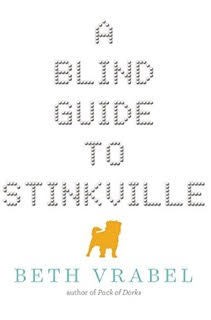Beth Vrabel’s middle-grade novel, “A Blind Guide to Stinkville,” introduces readers to Alice, a resilient 12-year-old navigating life with albinism and blindness after moving from Seattle to a small, odorous paper mill town in South Carolina, aptly nicknamed “Stinkville.” This interview delves into the inspiration behind the story, its themes, and the challenges of writing about disability and other complex issues for young audiences. The book offers a unique perspective on “a blind guide to Stinkville” as Alice finds her way in a new environment.
Kirkus Reviews highlights the novel’s nuanced portrayal of disability, noting Alice’s “rarely explored ambivalence of being disabled on a spectrum.” This captures Alice’s experience of using some tools while rejecting others, a contrast to more simplistic depictions of disability.
The Inspiration Behind Alice’s Story
Vrabel shares that her daughter, who has a mild form of albinism, served as a key inspiration for Alice’s character. Witnessing her daughter’s challenges and the misconceptions surrounding albinism motivated Vrabel to create a more authentic representation.
“I didn’t realize that albinism runs on a spectrum,” Vrabel explains. She emphasizes the initial uncertainty surrounding her daughter’s visual acuity and the desire to portray a character who is more than just her diagnosis: a strong, capable, and smart girl who “just happens to have albinism.” The “a blind guide to Stinkville” theme is reflected in Alice’s resilience and determination to navigate her new surroundings.
Stinkville as a Character
The setting of Stinkville, a town dominated by a paper mill and its pervasive odor, plays a crucial role in the story. Vrabel drew inspiration from her own childhood in a paper mill town, where the mill was central to the community’s identity.
The smell of the paper mill serves as a constant reminder of Alice’s move and a unique sensory detail, given her blindness. Vrabel explains, “I knew I wanted Alice to have a constant reminder of her move and it couldn’t be anything too visual, given her blindness. Enter the paper mill!” This emphasizes “a blind guide to Stinkville” and how Alice experiences the town through her other senses.
Addressing Adult Depression in Middle Grade Fiction
Vrabel tackles the sensitive topic of adult depression through Alice’s mother’s struggles with the move. She acknowledges the difficulty of writing about this issue for middle grade readers, highlighting the impact of the mother’s depression on the entire family.
Alice grapples with her mother’s fluctuating moods and the family’s attempts to cope. Vrabel emphasizes the importance of portraying the need for “time, medical care, and love” for recovery, challenging the notion that a child can simply “snap her mother out of it.”
Connecting “Otherness”: Disability and Race
The novel also explores themes of race and the Civil Rights movement through the story of the Williams Café, a local establishment that played a significant role in promoting integration. Vrabel connects the experiences of those with disabilities and minority groups, emphasizing the commonality of facing challenges and exclusion.
She champions the We Need Diverse Books movement, highlighting the power of diverse characters like Alice and Kerica, who “make big differences in their community because of—not despite of—their challenges.” The theme of “a blind guide to Stinkville” thus extends to the broader issue of overcoming societal barriers and embracing diversity.
A Blind Guide to Normal: Continuing the Journey
Following “A Blind Guide to Stinkville,” Vrabel released “A Blind Guide to Normal,” featuring Ryder, a character introduced in the first book. Ryder, who lost an eye due to retinoblastoma, navigates the challenges of entering a “normal” school after attending a school for the blind. This expansion further explores the themes of acceptance and self-discovery. The “a blind guide to Stinkville” narrative set the stage for Ryder’s journey.
Through Alice’s and Ryder’s stories, Vrabel encourages readers to embrace their differences and find strength in the face of adversity. The novels champion inclusivity and offer valuable perspectives on navigating a world that isn’t always designed for everyone. The core message is about finding your own way, even with “a blind guide to Stinkville” or anywhere else.

